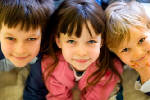What Are the Needs of Five Year Olds?
Ask Kytka Archives: July 22, 2002
This question comes just at the right time.
The lovely Ms. Joan Almon, Waldorf Kindergarten Master Teacher and Chairman of the Waldorf Kindergarten Association has allowed us to reprint this article:
What Are The Needs of Five Year Olds?
by Joan Almon
A Waldorf kindergarten is an extension of the family experience, an intermediate step for the child between the home and formal schooling. The goal is to provide a warm, calm, secure, aesthetic environment in which the imagination and creativity of the child will flourish.
The quality of the environment of a Waldorf kindergarten is integral to its goals for the children. The feeling of warmth and security is created by using only natural materials: woods, cotton, wool in the construction of the decor and toys. The curtains transmit a warm glow into the room. In this warm environment are placed toys which the children can use to imitate and transform the activities that belong to everyday adult life. In one corner stands a wooden scale and baskets for children to pretend they are grocery shopping; a pile of timber stands ready to be constructed into a playhouse, a boat or a train; a rocking horse invites a child to become a rider; homemade dolls lie in wooden cradles surrounded by wooden frames and cloths the children can use to create a pretend family and play house.

Pinecones and flowers are artistically dispersed; lovely watercolors adorn the walls. The effect of this beautiful arrangement of decorations and toys is a feeling of entering a “children’s garden”, where one can breathe easily, relax and play according to the impulses of one’s heart.
The 3 R’s are reverence, repetition, and rhythm. Structured group activities consist of finger plays, singing, reciting poems, and doing body movements known as eurythmy. Fairy tales are told to the children on successive days for up to two weeks, culminating in the tale as a puppet show offered to the children by the teacher or as a play with costumes acted out by the children with the teacher narrating. Art and crafts consist of water coloring with the three primary colors to impart a true appreciation of the nature of color, modeling with beeswax, drawing with beeswax crayons, finger knitting, and baking.
It has been noted that the fantasy play of children who attend the Waldorf kindergarten changes. Their fantasies are often about being the characters from the fairy tales told to them each week. The children become more respectful of one another, move with greater self-assurance and grace, and are much more open in their creative self-expression. This kind of growth, this kind of unfolding of the imagination and creativity through free play, art, drama, music, oral recitation, and dance are essential to our time.
The Importance of Child’s Play
One of the major changes in public school education in the past fifteen years has been the transformation of the kindergarten room from a “children’s garden” full of toys and playlike activity into a pre-first grade, full of work sheets and learning stations. There has been an assumption that all of this is appropriate for the five year old and will help the child in its academic work and in its growth and development in general. More and more, that assumption is now being challenged
In his book, The Hurried Child, David Elkind, child psychologist and professor at Tufts University, discusses the problem of stress that he finds in children who come to him for treatment. He points out that, in the great rush to bring children into academic work, we have ceased to ask if children are inwardly ready for such concentrated, intellectually-oriented work.
There is a growing body of research that supports the position of Waldorf schools that children should remain in play-oriented preschool until the age of six. The clearest example of such research which has come to our attention is a major study undertaken in Germany comparing 100 public school classes for five year olds. Fifty of them had only play in their program and the other 50 had academics and play together. The children entered first grade when they were six, and the study surveyed their progress until they were ten. The first year there was little difference to be seen. By the time the children were ten, however, those who had been allowed to play when they were five surpassed their schoolmates in every area measured. One can imagine how startling these results were to the state educators. They considered the results so conclusive that within months they had converted all of the academic programs back into play programs. They also recognized the advantages of mixed-age kindergartens in which, through play, the children help one another to grow and learn.
What is living in the five year olds that makes play such an important aspect of their growth and development? To answer this question, one needs to look at the progression of play throughout early childhood up to the age of six. For the two year old, play consists of doing what the adult does. Fantasy has not yet entered, and if one offers a two year old a cake made of sand, he is very likely to eat it. By the time the children turn three, this is no longer the case, for they are generally full of fantasy and imagination. This is a time of great fluidity in their play. They are inspired by whatever comes into their hand, and a single object will change its meaning for them several times during a single play session. For the parent this can be a frustrating stage, for the child generally leaves a stream of toys behind him as he moves about. It’s quite hopeless to tell him to put away a thing when he is finished. His play is always in the process of changing and becoming.
In the four year olds, one sees more constancy entering. They will build a house and stay in it for much longer periods of time than will the three year olds. Yet the inspiration for the house comes very much out of what catches their eye in the moment. This is no longer the case with five year olds. They will often enter the classroom and tell you exactly what they are going to build. They carry an image within themselves, but they still need the physical materials for carrying the image into play. This image may now last for weeks at a time, and thus one will have five year olds in a kindergarten building boats or “hide outs” day after day for a month or more.
Around the age of six, yet another change enters. It is one of the changes which we look for as a sign of readiness for first grade. Now the child’s image is so strong that toys or props are almost unnecessary. One Waldorf teacher described her own transition into this stage as follows. As a young child she loved to play with little toys and would set up scenes on a large window seat and play by the hour. One day, as she was turning six, she set a scene as usual, but then closed her eyes and played it all in her mind. I have seen six year olds in my kindergarten classes go through this same transition when they build their houses but cease to take any toys into them. They are now able to create everything they need in their mind’s eye, so to speak. It is quite a contrast to four and five year olds, who take as much as they can into their houses, leaving scarcely enough room in which to move. When such a stage has been reached, one feels the child is ready for studying the academic subjects which demand a capacity to hold an image of a letter or a number and call it up at will. Such a feat of memory is simply not possible for the younger child. He may compensate by developing little aids to jog his memory, but this is not the same as having a true readiness for the activity.
When we interfere with this process of development by starting the children on their academic subjects too soon, the imagination does not seem to develop fully. A certain dryness can enter into the intellectual process, and academic learning becomes less interesting as time goes on. What may first seem to be a gain soon disappears and as the German study indicated, can turn into a liability.
At first, we separated the kindergarteners from the younger children, but after two years we mixed the ages, primarily fours and fives, with a few three year olds, and were happy with the results. The younger children brought their fluidity into the play situations; the older ones brought their inner direction, and the two complemented one another very well. We also found that each age group came to the stories and activities in quite different ways, and each group took from the experience just what they needed for their development.
In addition, we have worked hard to develop a curriculum consistent with the preschool child’s dreamy, playful approach to life. For example, all the children paint with watercolor paints once a week. They work only with the three primary colors, and the youngest children are content to experience the pure colors in their most flowing form. The four and five year olds become intrigued with the discovery that additional colors can be created by mixing two colors, and the five and six year olds discover that the fluidity of the color on the wet paper can be controlled and forms and pictures begin to emerge. Fingers also learn to translate fantasy into form as the children model with beeswax, create tissue paper transparencies, sew with a needle and thread, or participate in other activities appropriate to their ages. Baking, whether it involves kneading the dough, rolling and cutting cookies, or cutting fruit for pies, also provides opportunities for the awakening intelligence of the child to penetrate into the fingers. The manual dexterity and eye-hand coordination which result from all these activities are essential for later academic work, yet to the young child this is all play.
It is also very important that language arts skills be developed during the preschool years and our curriculum is very rich in this area. During story time, the children develop listening skills, and as they grow older one sees how actively they listen, for as five and six year olds, they will often go home and repeat the whole fairy tale they have heard to their families. During circle time, they gladly learn songs and verses coupled with appropriate gestures and movements. Recently, I had the opportunity of sharing a fall harvest circle with a group of non-Waldorf preschool educators. They were amazed that a group of three and four year olds could participate in such a lengthy series of songs and verses, yet my class delighted in doing this little circle play over and over during the fall.
Through all such activities, we prepare the children for the academic work they will encounter in the first grade whether they [continue in our school], go to public school or to other private or religious schools. We have stayed in touch with our “graduates,” and we have been gratified to learn how well they have done. They generally experience a transition period of a month or two when they enter first grade, but by Christmas time, the children have mastered the same academic material as their peers and are functioning at their own level.
It is interesting to note that all the published studies which look into the question of early academics show disadvantages for children who begin academic work under the age of six. We have yet to find a study which reveals a long-term advantage to those starting early. More and more books are being published about the problems children encounter when rushed into academic work before true readiness has taken place. This can be a very confusing time for parents who see that their five year olds would like to learn their letters and numbers, and assume that their child is ready for academic work before a true form of academic readiness has actually taken place. In addition, one must contend with a great deal of social pressure from neighbors, friends, and family as to why one does not want to rush one’s child. Parents should feel free to discuss this question of school readiness with their child’s teacher. It is one of the most crucial questions affecting the lives of young children today.
* A very special thanks to Ms. Almon for this wonderful article!
Joan Almon, Waldorf Master Teacher, and Coordinator of the Alliance for Childhood in the United States.
Visit the website at: Alliance for Childhood
Used with permission.
Originally published in Leading Forth, Spring 1988, by the Baltimore Waldorf School.
Recommended Reading:
The Hurried Child: Growing Up Too Fast, Too Soon
Elkind calls readers attentions to the crippling stresses on children forced to grow up too fast, children mimicking adult sophistication while secretly yearning for innocence. Highly recommended reading.
Miseducation: Preschoolers at Risk
Elkind reveals and explains the serious risks entailed in the current craze for giving formal academic and physical instructions to pre-school children four years old and younger.
null





















